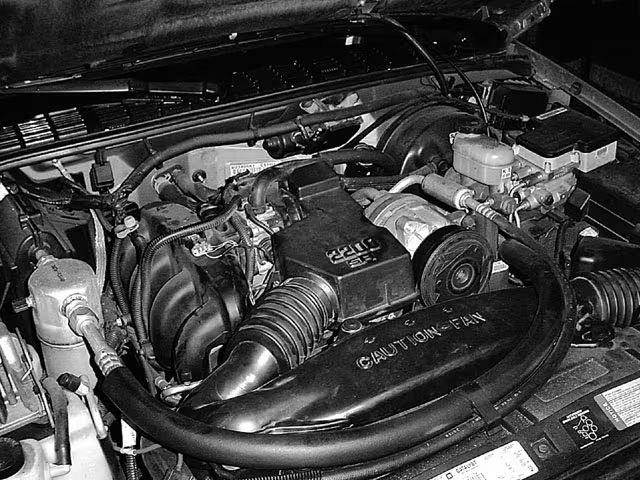Experiencing a bog down in your S10 2.2 when accelerating can be frustrating and concerning. This issue can stem from various causes, including fuel system problems, ignition failures, and transmission troubles. Understanding these potential issues can help you troubleshoot and get your vehicle back to optimal performance.
Understanding Bogging Down in Your S10
Bogging down refers to the situation where the vehicle struggles to accelerate smoothly, often resulting in reduced power and responsiveness. This sluggishness can occur at different speeds and may be accompanied by a variety of symptoms, such as unusual sounds or engine misfires.
Identifying the root cause of the bogging down is crucial to resolving the issue effectively. If left unaddressed, it may lead to more significant problems, impacting both your vehicle’s performance and its overall lifespan.
Common Causes of Bogging Down
- Fuel System ProblemsYour S10’s fuel system is critical for providing the right amount of fuel to the engine. If there is a blockage in the fuel filter, failing fuel pump, or clogged fuel injectors, it can prevent sufficient fuel from reaching the engine. This deficiency can cause the engine to struggle during acceleration, leading to a bogging down sensation.Regular fuel system maintenance is essential to avoid these issues. Consider changing the fuel filter periodically and running fuel system cleaners to keep the injectors clean. If the fuel pump is weak or fails, it will need to be replaced to restore fuel delivery to the engine.
- Ignition System FailuresThe ignition system in your S10 is responsible for firing the fuel-air mixture in the engine cylinders. If components such as spark plugs, ignition wires, or the ignition coil are worn or faulty, you may experience misfires, which can lead to poor acceleration.Worn spark plugs can cause weak sparks or even miss-firing, leading to incomplete combustion. This inefficiency not only affects acceleration but can also lead to increased fuel consumption. Regularly checking and replacing spark plugs, inspecting ignition wires for wear and ensuring the ignition coil is functioning properly are critical for optimizing engine performance.
- Transmission IssuesIf the bogging down occurs primarily during acceleration, it could be tied to transmission problems. Issues with the automatic or manual transmission, such as slipping gears or low transmission fluid levels, could hinder your ability to accelerate smoothly.Regular transmission maintenance is important to ensure smooth shifting and overall vehicle performance. This includes flushing the transmission fluid and addressing any leaks promptly. If you’re experiencing slipping or other issues, having a mechanic diagnose the problem can prevent further damage.
- Air Intake RestrictionsThe air intake system allows the engine to breathe properly by delivering the necessary air to mix with fuel for combustion. A clogged air filter or issues with the intake manifold can restrict airflow, leading to a rich fuel mixture and poor acceleration.Checking and replacing the air filter regularly can prevent airflow restrictions. If the issue lies in the intake manifold or related sensors, further inspection may be necessary. Ensuring the intake systems are clear of obstructions promotes better engine performance.
- Sensor FailuresModern vehicles, including the S10, rely heavily on various sensors to monitor and regulate engine performance. Sensors such as the Mass Air Flow (MAF) sensor, Throttle Position Sensor (TPS), and Oxygen sensors provide critical data to adjust fuel and air mixtures for optimal performance.If any of these sensors malfunction, it could lead to improper fuel-air mixtures, resulting in insufficient power during acceleration. Regular diagnostics can help detect sensor problems early, allowing for timely replacements and maintaining performance standards.
Maintenance Practices to Prevent Bogging Down
- Regular Tune-UpsOne of the most effective methods to prevent bogging down issues is to perform regular tune-ups on your S10. This includes replacing spark plugs, checking ignition components, and ensuring the fuel system is clean and functioning properly.Regular inspections can help catch any inconsistencies before they develop into bigger problems. Routine maintenance not only enhances performance but can also prolong the life of your vehicle.
- Monitoring Fuel QualityFuel quality can significantly impact engine performance. Consistently using low-quality fuel can lead to deposits forming in the injectors and fuel system. This can result in reduced efficiency and bogging down.Investing in high-quality fuel can help reduce carbon buildup and improve combustion efficiency. It may also be beneficial to use fuel additives that clean the fuel system.
- Keeping the Air Filter CleanA clean air filter is essential for optimal airflow to the engine. Clogged filters can lead to reduced performance and bogging down issues. Regularly checking and replacing the air filter can significantly improve engine response and overall performance.Depending on driving conditions, it’s generally a good idea to inspect the air filter every 12,000-15,000 miles, or sooner if you drive in dusty or dirty environments.
- Fluid ChecksRegularly check and maintain all fluid levels in your S10, including oil, transmission fluid, coolant, and brake fluid. Low fluid levels can lead to overheating, decreased performance, and other complications.Consider following a fluid change schedule provided in your owner’s manual to ensure all systems are functioning smoothly. Keeping your vehicle’s systems well lubricated is essential to prevent wear and enhance performance.
- Listening to Your VehiclePay attention to what your vehicle is telling you. Any unusual sounds, vibrations, or changes in performance should warrant a closer look. Ignoring potential warning signs can lead to more extensive damage, increasing repair costs.Establishing a habit of performing routine inspections and listening to your vehicle’s performance can provide early indicators of any necessary repairs or maintenance.
Troubleshooting Steps
If you find that your S10 is bogging down during acceleration, here are steps you can take to troubleshoot the issue:
- Check for Warning LightsStart by checking your dashboard for any warning lights that could indicate problems with the engine, transmission, or other systems. Diagnostic trouble codes from the On-Board Diagnostics (OBD-II) system can provide insights into where the problem lies.
- Inspect the Fuel SystemLook for signs of fuel system issues. Listen for the fuel pump when turning the ignition on; it should make a humming noise. If it’s silent, you may need to investigate the fuel pump or fuel filter.
- Examine the Ignition SystemInspect spark plugs and wires for wear and tear. Look for any corrosion on the terminals and ensure all connections are secure.
- Evaluate AirflowRemove and inspect the air filter to see if it is clogged with dirt or debris. Clean or replace as necessary and check the intake system for any blockages.
- Check Transmission Fluid LevelsIf using an automatic transmission, ensure fluid levels are correct. A dipstick can help you check the transmission fluid, which should appear clean and reddish in color.
By following these troubleshooting steps, you may discover the root cause of the bogging down issue and proceed with repairs accordingly.
Conclusion
Experiencing a bog down in your S10 2.2 when accelerating can be due to various issues, from fuel and ignition system problems to airflow restrictions and transmission troubles. Understanding these potential causes, along with proper maintenance practices, is crucial for ensuring your vehicle performs at its best. Regular check-ups, along with timely repairs, can help you avoid further complications and enjoy a smoother driving experience. If you’re unable to identify the issue, consulting with a qualified mechanic is recommended.
FAQs
- What are some signs that my fuel pump may be failing?Common signs of a failing fuel pump can include difficulty starting the engine, sputtering during acceleration, and a decrease in fuel efficiency.
- How often should I change my spark plugs?Generally, it’s a good idea to change spark plugs every 30,000 to 100,000 miles, depending on the type and manufacture recommendations.
- Is it okay to ignore a slight bogging down issue?It’s advisable not to ignore any performance issues. A slight bog down can indicate underlying problems that could worsen over time.
- How does a dirty air filter affect performance?A dirty air filter restricts airflow into the engine, causing poor combustion and reduced engine performance, often leading to bogging down during acceleration.
- Can sensor failures trigger check engine lights?Yes, faulty sensors can trigger check engine lights. If your check engine light is on, it’s essential to diagnose the problem as soon as possible.



